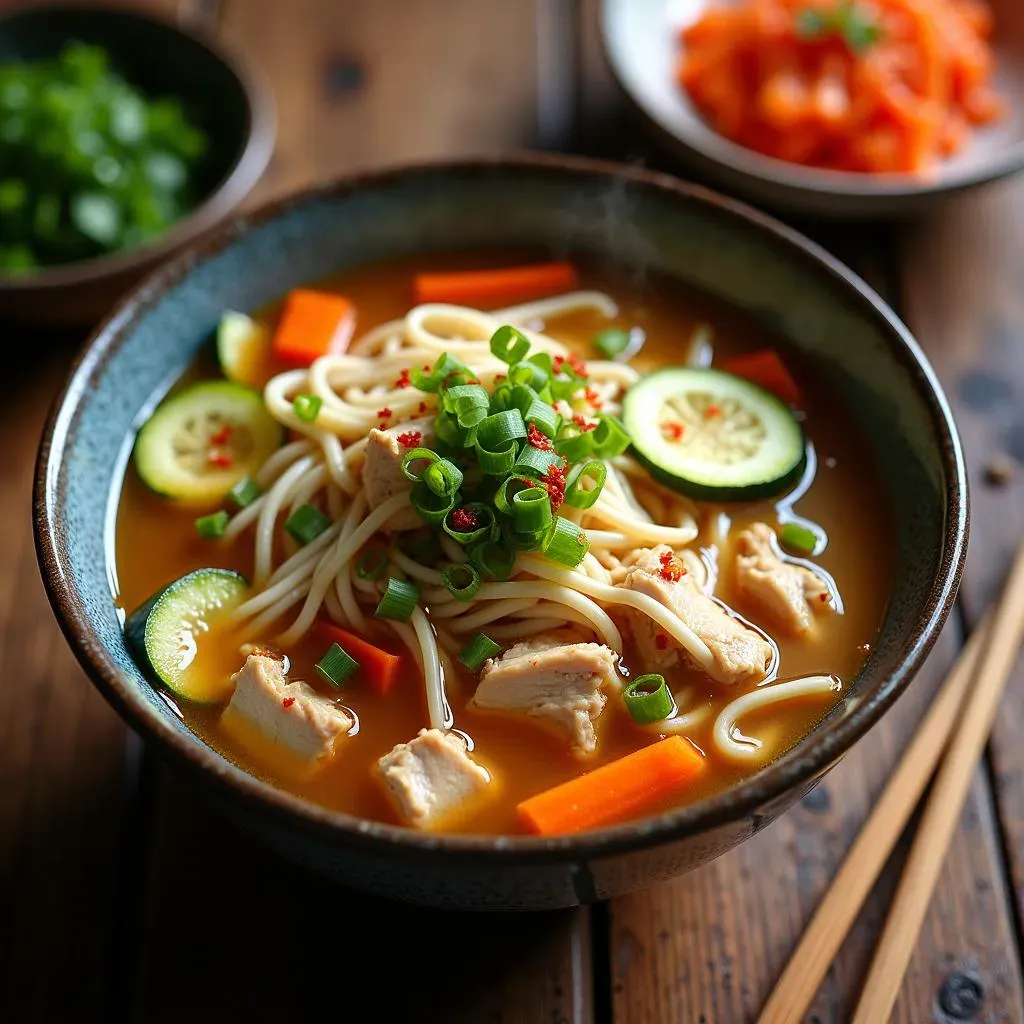Table of Contents
Craving a bowl of comfort that goes beyond the ordinary? Let's talk chicken noodle soup recipe korean style! Dak Kalguksu, or Korean chicken noodle soup, is a dish that warms the soul with its rich, savory broth and delightfully chewy, knife-cut noodles. Forget what you think you know about chicken noodle soup – this is a flavor adventure. We're diving deep into the heart of Dak Kalguksu, exploring its origins, and uncovering the secrets to making a truly unforgettable version at home.
What is Dak Kalguksu: Exploring Korean Chicken Noodle Soup
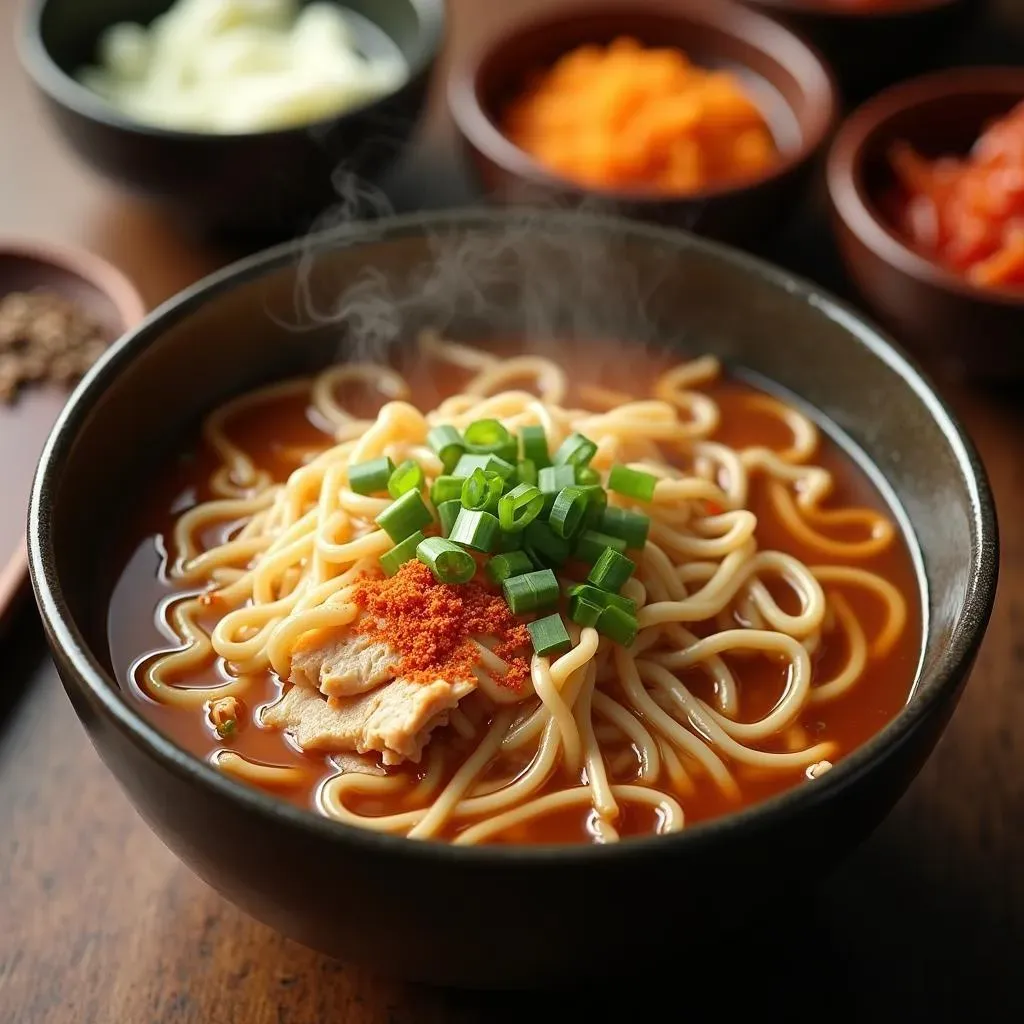
What is Dak Kalguksu: Exploring Korean Chicken Noodle Soup
So, what exactly *is* Dak Kalguksu? Simply put, it's Korean chicken noodle soup. But that description barely scratches the surface. "Dak" means chicken, and "Kalguksu" refers to knife-cut noodles. Think of it as the ultimate comfort food in Korea, often enjoyed as a stamina booster, especially during the hot summer months. It's a hearty, flavorful soup featuring chewy, handmade-style noodles swimming in a rich chicken broth. It's the kind of dish that makes you feel all warm and fuzzy inside.
Unlike some other Korean dishes that pack a fiery punch, Dak Kalguksu is generally mild and comforting. Of course, you can always add a spicy kick with some gochugaru (Korean chili powder) or a dab of gochujang (Korean chili paste), but the base flavor is all about that deeply satisfying chicken broth. It's a dish that's both familiar and exotic, offering a taste of Korean culinary tradition in every spoonful. Seriously, if you're looking for a chicken noodle soup that's a little bit different, a little bit special, Dak Kalguksu is where it's at.
Upgrading Your Chicken Noodle Soup: A KoreanInspired Recipe
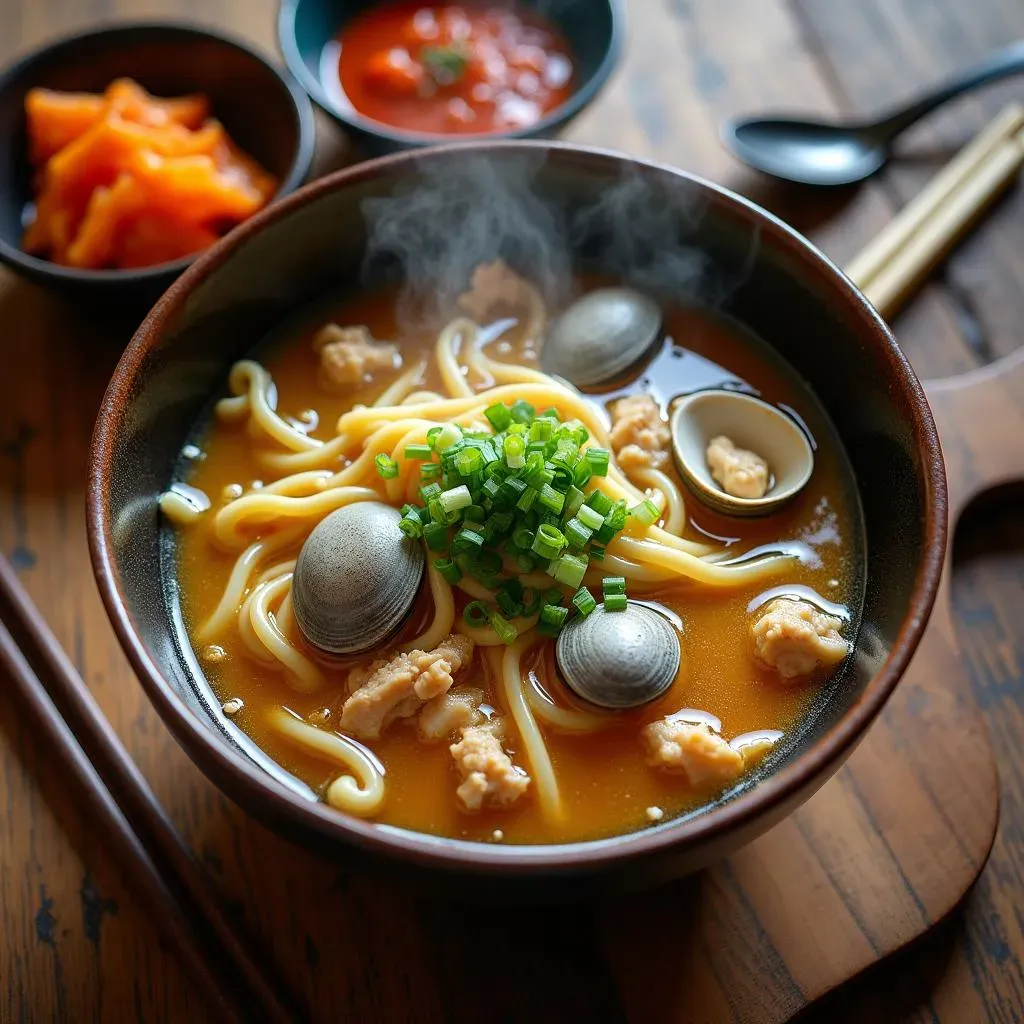
Upgrading Your Chicken Noodle Soup: A KoreanInspired Recipe
The Secret's in the Broth
so you've got your basic chicken noodle soup down. Now, let's crank it up a notch! The key to an amazing Dak Kalguksu is all in the broth. We're not just talking about simmering chicken in water here. We want a deeply flavorful, complex broth that sings with umami. The classic recipe uses chicken backs (or frames) for maximum flavor at a minimal cost. Throw in some chicken drumsticks for actual meat you can shred and add back to the soup. But here's where the magic happens: dried anchovies and little neck clams.
I know, I know, anchovies in chicken noodle soup sounds a little weird, right? But trust me on this one. The dried anchovies add a salty, savory depth that's seriously addictive. And the clams? They bring a briny sweetness that balances the richness of the chicken. It's a total game-changer. Think of it like this: you're building layers of flavor. Each ingredient contributes something unique, resulting in a broth that's far more interesting than your average chicken soup. It's like the difference between a simple melody and a full-blown symphony!
Broth Base Ingredients
- Chicken Backs (Frames): Economical and packed with flavor.
- Chicken Drumsticks: Adds meat to the soup.
- Dried Anchovies: Provides a salty, savory depth (remove after simmering).
- Little Neck Clams: Brings a briny sweetness.
- Aromatics: Garlic, ginger, and scallions for fragrance.
Putting it All Together
So, how do you actually *make* this upgraded broth? It's surprisingly simple. Start by simmering the chicken backs, dried anchovies, garlic, ginger, and scallions in a large pot of water for at least an hour. This allows all those flavors to meld together and create a rich base. Then, add the chicken drumsticks and continue simmering until they're cooked through. Remove the drumsticks and set them aside to cool slightly before shredding the meat. Now, here's the important part: strain the broth to remove the chicken bones, anchovies, and aromatics. This will give you a clear, clean broth that's ready for the final touches.
Once you've strained the broth, bring it back to a simmer and add the clams. Cook until the clams open, then remove them from the pot. Finally, add your noodles (we'll talk about noodle options in the next section) and cook until they're tender. Serve the soup hot, garnished with the shredded chicken meat and the cooked clams. You can also add some chopped scallions or a drizzle of sesame oil for extra flavor. And if you're feeling adventurous, whip up a batch of spicy seasoning sauce (gochujang, garlic, sesame oil, soy sauce) for those who like a little heat. Trust me, your taste buds will thank you.
Flavor Boosters
Kalguksu Noodles and More: Choosing the Right Noodles for Your Korean Chicken Noodle Soup
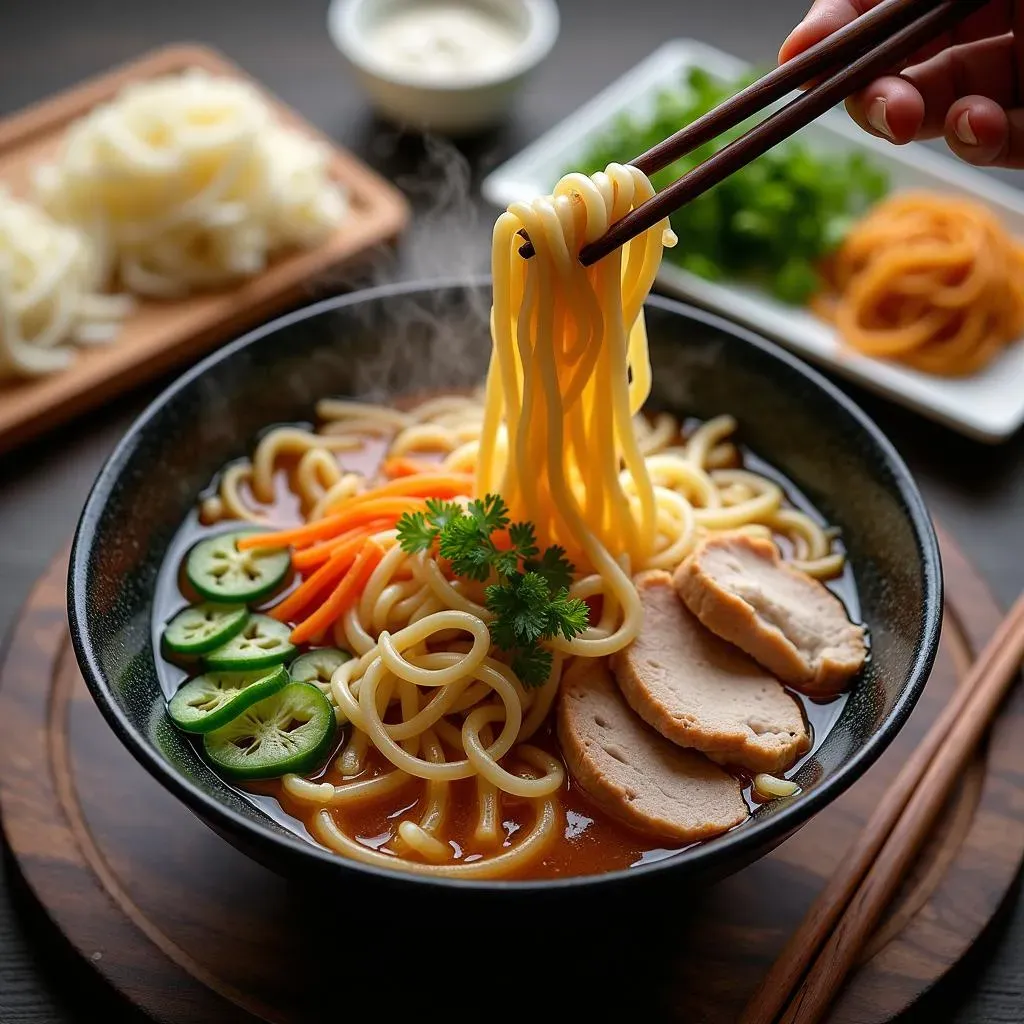
Kalguksu Noodles and More: Choosing the Right Noodles for Your Korean Chicken Noodle Soup
The Real Deal: Knife-Cut Kalguksu
Alright, let's talk noodles! If you're going for authenticity, nothing beats true kalguksu noodles. These are thick, flat noodles made from wheat flour and, as the name suggests, traditionally cut by hand with a knife. This gives them a slightly uneven texture, which is part of their charm. They have a wonderful chewiness that's just perfect for soaking up all that delicious broth. Finding them can be a bit of a treasure hunt, though. Look for them at Korean grocery stores, either fresh or dried. Fresh is always best, but dried works in a pinch. Just be sure to cook them according to the package directions, as cooking times can vary.
The beauty of these noodles lies in their simplicity. They're not overly flavored, allowing the broth to really shine. They're also incredibly satisfying to eat. That slight chewiness I mentioned? It's addictive! And because they're a bit thicker than your average noodle, they hold up well in the soup without getting mushy. Trust me, once you've had Dak Kalguksu with proper kalguksu noodles, it's hard to go back to anything else.
When in Doubt: Acceptable Substitutes
so maybe you can't find kalguksu noodles. Don't panic! There are definitely acceptable substitutes that will still give you a delicious bowl of Dak Kalguksu. My top pick would be udon noodles. They have a similar thickness and chewiness to kalguksu, and they're much easier to find at most grocery stores. Another good option is hand-torn sujebi noodles. These are also made from wheat flour, but instead of being cut with a knife, they're torn into irregular shapes by hand. This gives them a rustic, homemade feel that's very similar to traditional kalguksu.
If you're really in a bind, you could even use fettuccine pasta. It's not quite the same, but it's better than nothing! Just be sure not to overcook it, as it can get mushy very easily. The key is to choose a noodle that's thick enough to stand up to the broth and has a good chew. Avoid thin noodles like angel hair or vermicelli, as they'll just disappear in the soup. Remember, the noodles are an important part of the overall experience, so choose wisely!
Noodle Type | Texture | Availability | Best Use |
|---|---|---|---|
Kalguksu | Chewy, slightly uneven | Korean grocery stores | Authentic Dak Kalguksu |
Udon | Smooth, chewy | Most grocery stores | Good substitute for Kalguksu |
Sujebi | Rustic, chewy | Korean grocery stores | Homemade feel |
Fettuccine | Flat, firm | Most grocery stores | Emergency substitute |
Noodle Know-How: Cooking Tips
No matter which type of noodle you choose, there are a few key things to keep in mind when cooking them. First, always cook them separately from the broth. This prevents the broth from becoming starchy and cloudy. Bring a pot of water to a boil, add the noodles, and cook until they're just tender. Then, drain them well and add them to the broth right before serving. This will ensure that they don't get overcooked and mushy.
Another important tip is to rinse the noodles after cooking. This helps to remove any excess starch and prevents them from sticking together. Just give them a quick rinse under cold water, then drain them thoroughly. Finally, don't be afraid to experiment with different cooking times. Every brand of noodle is different, so it's important to taste them as they cook and adjust the cooking time accordingly. The goal is to achieve a perfectly cooked noodle that's tender but still has a bit of bite.
Dak Kalguksu Recipe: How to Make Korean Chicken Noodle Soup
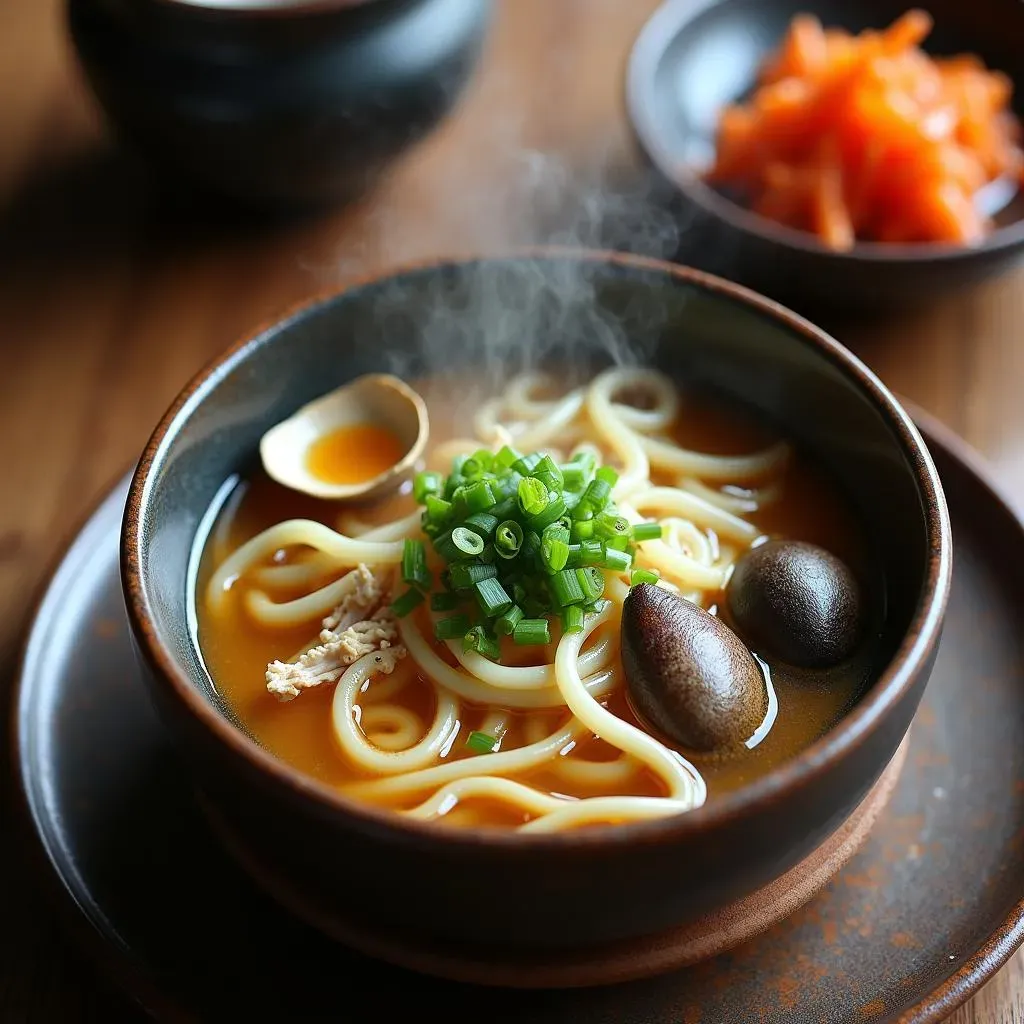
Dak Kalguksu Recipe: How to Make Korean Chicken Noodle Soup
Broth is Boss: Building the Flavor Foundation
Alright, let's get down to business! The heart of any great Dak Kalguksu is, without a doubt, the broth. This isn't your average, run-of-the-mill chicken broth. We're talking about a deeply flavorful, complex concoction that's going to make your taste buds sing. Start with about 8 cups of water in a large pot. Add your chicken backs (about 1 pound), 4-5 dried anchovies (remove the heads and guts for a cleaner flavor), 3-4 cloves of garlic (roughly chopped), a thumb-sized piece of ginger (sliced), and a couple of scallions (roughly chopped). Bring it all to a boil, then reduce the heat and let it simmer for at least an hour, or even longer if you have the time. The longer it simmers, the more flavorful it will become.
After an hour, add about 1 pound of chicken drumsticks to the pot. These will add some actual meat to the soup, which is always a good thing. Continue simmering for another 30 minutes, or until the drumsticks are cooked through. Remove the drumsticks from the pot and set them aside to cool slightly. Once they're cool enough to handle, shred the meat and set it aside. Now, here's the key step: strain the broth through a fine-mesh sieve to remove all the solids. This will give you a clear, clean broth that's ready for the next stage.
If you're using clams (and I highly recommend that you do!), add them to the strained broth now. About a pound of little neck clams should do the trick. Cover the pot and cook until the clams open, usually about 5-7 minutes. Discard any clams that don't open. Remove the clams from the pot and set them aside. Now, your broth is officially ready for the noodles!
Noodle Time: Cooking to Perfection
Now that your broth is simmering and smelling amazing, it's time to cook the noodles. As we discussed earlier, kalguksu noodles are the traditional choice, but udon or sujebi noodles will also work well. Cook the noodles according to the package directions. Remember, it's important to cook the noodles separately from the broth to prevent the broth from becoming starchy and cloudy. Once the noodles are cooked, drain them well and rinse them under cold water to remove any excess starch.
Once the noodles are cooked and drained, it's time to assemble the soup. Ladle the hot broth into bowls, add a portion of the cooked noodles, and top with the shredded chicken and the cooked clams. Garnish with some chopped scallions and a drizzle of sesame oil, if desired. And if you're feeling spicy, add a spoonful of gochujang or a sprinkle of gochugaru to your bowl. Serve immediately and enjoy!
Serving Suggestions: Spice It Up!
Dak Kalguksu is fantastic on its own, but there are a few things you can do to take it to the next level. One popular addition is a spicy seasoning sauce made with gochujang (Korean chili paste), garlic, sesame oil, and soy sauce. Just mix these ingredients together to taste and add a spoonful to your soup for an extra kick. Another great option is to serve the soup with a side of kimchi (Korean fermented cabbage). The spicy, tangy kimchi provides a nice contrast to the rich, savory broth.
You can also add other vegetables to the soup, such as zucchini, carrots, or potatoes. Just dice them into small pieces and add them to the broth along with the chicken drumsticks. And if you're feeling really fancy, you can top the soup with a fried egg. The runny yolk adds a richness and creaminess that's simply divine. No matter how you choose to serve it, Dak Kalguksu is sure to be a hit. It's a comforting, flavorful, and satisfying meal that's perfect for any occasion.
So there you have it! My take on a classic Korean comfort food. It's a dish that's close to my heart, and I hope you enjoy making it as much as I do. Don't be afraid to experiment with different variations and make it your own. After all, cooking is all about having fun and creating something delicious. Happy cooking!
Ingredient | Quantity | Notes |
|---|---|---|
Water | 8 cups | For the broth |
Chicken Backs | 1 pound | For flavor |
Dried Anchovies | 4-5 | Remove heads/guts |
Garlic | 3-4 cloves | Roughly chopped |
Ginger | 1 thumb-sized piece | Sliced |
Scallions | 2 | Roughly chopped |
Chicken Drumsticks | 1 pound | For meat |
Little Neck Clams | 1 pound | Optional, but recommended |
Kalguksu Noodles | 8 ounces | Or udon/sujebi |
Sesame oil | Drizzle | For garnish |
Gochujang | To taste | Optional, for spice |
A Taste of Korea: Savoring Your Homemade Dak Kalguksu
And there you have it – your very own bowl of comforting, authentic Dak Kalguksu! This Korean chicken noodle soup recipe is more than just a meal; it's an experience. With each spoonful, you're transported to the bustling streets of Seoul, savoring the flavors that have warmed hearts for generations. Whether you stick to the classic recipe or experiment with your own variations, I hope this guide has inspired you to explore the wonderful world of Korean cuisine. So gather your friends and family, ladle up a generous serving, and enjoy the deliciousness of Dak Kalguksu. Happy cooking!
